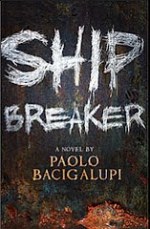 Nailer is a slum rat, a ship breaker who spends his days crawling through ducts on dead oil-burning ships, stripping out the precious copper wire. On the beach, loyalty is almost everything, second only to large quantities of money; you trust your crew, sworn by blood, but you try not to make them choose between you and a lucky strike. After a City Killer hurricane, he finds a lucky strike–an elegant modern ship, containing more gold, silver, and general Stuff Worth Money than he’s seen in his life, but before he can trade in the scavenge for money, he also finds a girl. Alive, and promising more wealth if he keeps her alive than if he lets her die.
Nailer is a slum rat, a ship breaker who spends his days crawling through ducts on dead oil-burning ships, stripping out the precious copper wire. On the beach, loyalty is almost everything, second only to large quantities of money; you trust your crew, sworn by blood, but you try not to make them choose between you and a lucky strike. After a City Killer hurricane, he finds a lucky strike–an elegant modern ship, containing more gold, silver, and general Stuff Worth Money than he’s seen in his life, but before he can trade in the scavenge for money, he also finds a girl. Alive, and promising more wealth if he keeps her alive than if he lets her die.
The worldbuilding is fantastic. It’s imaginative, but flows logically from our own world and decisions. City Killers and the wreckage of several cities where New Orleans once stood, shipping routes across the now-liquid North Pole, the greater disparity between rich and poor and the lack of mobility caused by running out of fossil fuels . . . Bacigalupi crafted a world rich in detail, and it’s frighteningly plausible. Ship Breaker doesn’t feel didactic, though; it’s a warning, not a sermon.
The plot is serviceable, but not much more. It gets Nailer to explore his world, and we get to come along for the ride. Much of the conflict revolves around company squabbles between the family of Nita, the wealthy girl he rescued, and rivals within their shipping company; Nailer doesn’t understand the nuances of the conflict, and neither do we. He’s in it because he became friends with Nita, not because he cares who rules the company. That’s believable and fits his character, but makes it less compelling to the reader. We know which side we’re on, but we don’t know why it’s the right side. Other than that Nailer’s brutal, drug-addled, violent father is on the other side, so they must be bad. Towards the end, it takes a turn for the swashbuckling, which changes feel significantly from the gritty dystopia that opened the novel. Personally, I liked the dystopia better than the swashbuckling.
The characters are a mixed bag. Nailer is great; well-developed, compelling, and interesting. Observant, unsatisfied with his world, and courageous, he’s a good focal point. Several other characters left me wishing for more.. A halfman–genetically modified, combining human, dog, and tiger DNA–enriches our understanding of the world, particularly in his interactions with other halfmen, but he never explains the differences between him and the other halfmen. Nailer’s best friend’s mother is similarly interesting, hinting at complexity of character and the world, but she gets little page-time. And the rest of the characters are means to an end, rather than people. Nita is particularly underdeveloped; she is crucial to the plot and nearly always present, but has little in the way of independent personality. She knows what the plot needs her to know and can do what the plot needs her to do, but we never get a sense that she knows and does because she wants or needs to.
It’s still a compelling, gripping book. The worldbuilding is worth the read, and if the plot and characters pale a little beside the rich world, they’re enough to lead us along on the exploration of the world.
____________________
Ship Breaker ~ Paolo Bacigalupi
August 16, 2010 at 6:42 pm
Hi Miriam,
I love your blog. Very classic looking.
I lifted your review of 7 Realms (with credit to you, and permission from your mom) for our Children’s email newsletter going out tomorrow.
I liked it, too, and think it will be a good gift selection this fall.
Pat